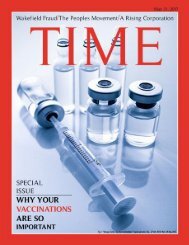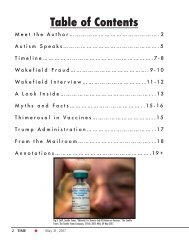JEP fin
You also want an ePaper? Increase the reach of your titles
YUMPU automatically turns print PDFs into web optimized ePapers that Google loves.
ples to try and counter the CDC’s statement, the first being a description of a CDC whistleblower,<br />
and the link they have for the proof comes up with “Nothing Found.” The second is the<br />
Hannah Poling case where the NVICP awarded her family $1.5 million for “vaccine’s role in her<br />
autism related diagnosis.” They did not even link supporting evidence for this, just the NVICP<br />
website. What they did not say is that the Court clarified that the “Hannah Poling case “does not<br />
afford any support to the notion that vaccinations can contribute to the causation of autism.”<br />
Rao, T.S. Sathyanarayana, and Chittaranjan Andrade. “The MMR Vaccine and Autism: Sensation, Refutation,<br />
Retraction, and Fraud.” Indian Journal of Psychiatry. National Center for Biotechnology Information.<br />
Accessed 14 Mar. 2017. Originally published in Indian Journal of Psychiatry.<br />
In this article by T.S. Rao’s article about MMR vaccine fraud, it labels the Andrew Wakefield<br />
fraud as one of the most serious in medical history. It briefly goes into the flaws of Wakefields<br />
experiment, how the public took the results, and the effect the case series when it came out and<br />
even years down the line. To start, his experiment, he and 12 co-authors had a very small sample<br />
size of 12 individuals, not nearly enough to gather accurate and sufficient data and apply it on a<br />
massive scale later on. The experiment design was relatively uncontrolled, and the conclusions<br />
were very speculative. These factors create results that are unreliable, but yet the case series<br />
received widespread publicity after being published in the Lancet in February of 1998, leading<br />
to a drop in vaccination rates due to the fear that they cause autism. Even though the paper was<br />
minor, the effect was widespread, organizations spending large amounts of time and money<br />
refuting the paper, and parents across the world not vaccinating their children out of fear of risk<br />
of autism. This is the cause of the 2008-2009 outbreaks of measles in the UK, and smaller cases<br />
of outbreaks in the United States and Canada. The article was then retracted in 2010 after the<br />
British General Medical Council reported that “Wakefield had acted dishonestly, irresponsibly,<br />
unethically, and callously in connection with the research project and its subsequent publication.”<br />
Ten out of the twelve co-authors were in favor of the retraction, and a statement of the retraction<br />
says that “no causal link was established between MMR vaccine and autism as the data were<br />
insufficient.” Wakefield was later found guilty of deliberate fraud.<br />
This source is useful, and will be used in my paper as it will build my refutation. In comparison<br />
with a source by Frank DeStefano and Robert T Chen posted on The Lancet, I found that both<br />
sources support the negative association between MMR and autism. Both also recognize the<br />
hypothesis that some cases have created a lot of media attention in the UK, causing a drop in<br />
May 31, 2017 TIME 45





